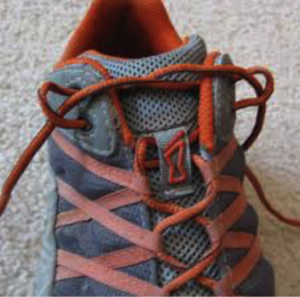LACING YOUR SHOES TO CREATE A BETTER FIT

Tid Bits of Info
- Shoe strings or laces that are made of natural fiber tend to stay tied more effectively but are subject to “dry rot” more easily.
- Try on running shoes later in the day and after you have been weight bearing because your feet will be slightly swollen and similar to running size.
- Flat tubular laces will stay tied better than round laces.
- Puma was the first shoe manufacturer to put Velcro fasteners on their shoes in 1968.
- If you have an injured foot or have pain in your foot, seek the advice of a Physical Therapist.
Some of us spend hours choosing the proper shoe to wear for various events, but we don’t usually think about how lacing a shoe also impacts comfort. If a shoe doesn’t always fit right, it can cause pain throughout the foot. In some cases, lacing your shoes differently can play a key role to increase comfort.
Typically, we lace up our shoes with a “criss-cross” method. Most of the time, this provides sufficient support and comfort as we perform daily activities, so our feet remain relatively pain-free. Other times, we may experience pain in a certain area because the shoes are too tight or too loose or there is too much pressure in a specific area. Here are three simple modifications to lacing your shoes that can help increase your comfort.
Straight bar lacing:
If your shoe that feels too tight, the problem could be a result of the foot swelling after prolonged weight bearing. If the shoe feels too tight, this lacing method will allow the top of the foot to have “more” room and the shoe will feel less snug.
Begin straight across on the outside and in through the bottom eyelets.
• The left end runs straight up on the inside, then straight across on the outside.
• Both ends run straight up on the inside, each skipping one eyelet and emerging two eyelets higher up.
• Both ends continue straight across on the outside and in through the adjacent eyelets.
• Alternate running up on the inside and across on the outside until lacing is completed.
Gap lacing:
This type of lacing is used when an area of the foot has too much pressure applied to it due to the fit of the shoe. People with high arches or wide feet can benefit from this method of lacing. The laces are criss-crossed through the eyelets above and below the area of the foot that has too much pressure applied to it. The laces “skip” the criss-cross pattern at the eyelet above and below the involved area.
Begin straight across on the inside and out through the bottom eyelets.
• At each eyelet pair, cross the ends, feeding under the sides and out through the next higher set of eyelets. Repeat until the ends are below the sensitive area (or ankle area).
• The ends are run straight up the sides to the next higher set of eyelets, creating the gap.
• Starting above the sensitive area (or ankle area), resume criss-crossing up the shoe until lacing is completed.
Loop lacing:
This method is great to reduce “heel slippage”. If your shoe feels loose and your heel is moving up and down in the shoe it can lead to blisters and a sense of insecurity due to a poor fitting shoe. You might feel as if your heel is going to slide out of your shoe. The loop lacing “locks” the shoe around your heel and keeps your heel snuggly in the shoe.
• Pull laces out of top hole and lace into the same side hole as shown, leaving two loops
• Step 2 – Take ends and put through opposite loop
• Step 3 – Tighten and tie bow as usual
Lacing your shoe properly can help to relieve or resolve the symptoms that cause problems with your feet. If you cannot resolve your symptoms you might benefit from visiting a Physical Therapist. You can go to them without a doctor’s prescription and they can evaluate and treat your ailments. They will be able to assess you symptoms and help you resolve them via exercises, modalities and possibly manual techniques.
Shoes must be comfortable or you will not be able to perform at your highest level. Regardless of the activity that you are performing an ill-fitting shoe will make it miserable. In contrast, a shoe that fits properly can help you perform at a higher level because you are comfortable and have no concerns with your feet.


























Useful information. The gap lacing technique was new to me.